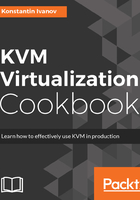
上QQ阅读APP看书,第一时间看更新
How to do it...
The following steps outline the process of inspecting and editing the XML definition of a KVM instance:
- Ensure that you have a running KVM instance with libvirt, if not, follow the steps in the previous recipe:
root@kvm:~# virsh list
Id Name State
----------------------------------------------------
11 kvm1 running
root@kvm:~#
- Dump the instance configuration file to standard output (stdout). For more information on stdout refer to folllowing link:
https://en.wikipedia.org/wiki/Standard_streams
root@kvm:~# virsh dumpxml kvm1
<domain type='kvm' id='11'>
<name>kvm1</name>
<uuid>9eb9a2e9-abb2-54c5-5cb3-dc86728e70fc</uuid>
<memory unit='KiB'>1048576</memory>
<currentMemory unit='KiB'>1048576</currentMemory>
<vcpu placement='static'>1</vcpu>
<resource>
<partition>/machine</partition>
</resource>
<os>
<type arch='x86_64' machine='pc-i440fx-trusty'>hvm</type>
<boot dev='hd'/>
</os>
<features>
<acpi/>
<apic/>
<pae/>
</features>
<clock offset='utc'/>
<on_poweroff>destroy</on_poweroff>
<on_reboot>restart</on_reboot>
<on_crash>restart</on_crash>
<devices>
<emulator>/usr/bin/qemu-system-x86_64</emulator>
<disk type='file' device='disk'>
<driver name='qemu' type='raw'/>
<source file='/tmp/debian.img'/>
<target dev='hda' bus='ide'/>
<alias name='ide0-0-0'/>
<address type='drive' controller='0' bus='0' target='0' unit='0'/>
</disk>
<controller type='usb' index='0'>
<alias name='usb0'/>
<address type='pci' domain='0x0000' bus='0x00' slot='0x01' function='0x2'/>
</controller>
<controller type='pci' index='0' model='pci-root'>
<alias name='pci.0'/>
</controller>
<controller type='ide' index='0'>
<alias name='ide0'/>
<address type='pci' domain='0x0000' bus='0x00' slot='0x01' function='0x1'/>
</controller>
<interface type='network'>
<mac address='52:54:00:d1:70:df'/>
<source network='default'/>
<target dev='vnet0'/>
<model type='rtl8139'/>
<alias name='net0'/>
<address type='pci' domain='0x0000' bus='0x00' slot='0x03' function='0x0'/>
</interface>
<serial type='pty'>
<source path='/dev/pts/0'/>
<target port='0'/>
<alias name='serial0'/>
</serial>
<console type='pty' tty='/dev/pts/0'>
<source path='/dev/pts/0'/>
<target type='serial' port='0'/>
<alias name='serial0'/>
</console>
<input type='mouse' bus='ps2'/>
<input type='keyboard' bus='ps2'/>
<graphics type='vnc' port='5900' autoport='yes' listen='146.20.141.158'>
<listen type='address' address='146.20.141.158'/>
</graphics>
<video>
<model type='cirrus' vram='9216' heads='1'/>
<alias name='video0'/>
<address type='pci' domain='0x0000' bus='0x00' slot='0x02' function='0x0'/>
</video>
<memballoon model='virtio'>
<alias name='balloon0'/>
<address type='pci' domain='0x0000' bus='0x00' slot='0x04' function='0x0'/>
</memballoon>
</devices>
<seclabel type='none'/>
</domain>
root@kvm:~#
- Save the configuration to a new file, as follows:
root@kvm:~# virsh dumpxml kvm1 > kvm1.xml
root@kvm:~# head kvm1.xml
<domain type='kvm' id='11'>
<name>kvm1</name>
<uuid>9eb9a2e9-abb2-54c5-5cb3-dc86728e70fc</uuid>
<memory unit='KiB'>1048576</memory>
<currentMemory unit='KiB'>1048576</currentMemory>
<vcpu placement='static'>1</vcpu>
<resource>
<partition>/machine</partition>
</resource>
<os>
root@kvm:~#
- Edit the configuration in place and change the available memory for the VM:
root@kvm:~# virsh edit kvm1
Domain kvm1 XML configuration edited.
root@kvm:~#